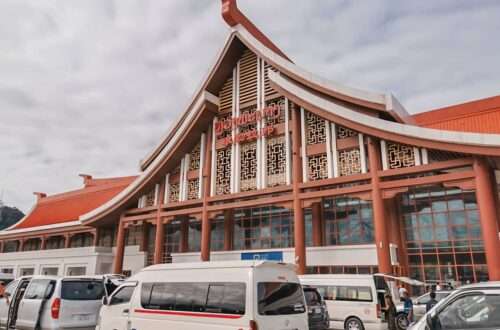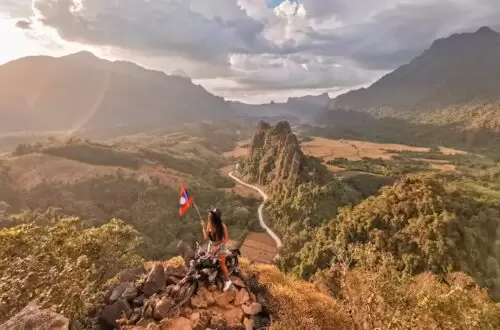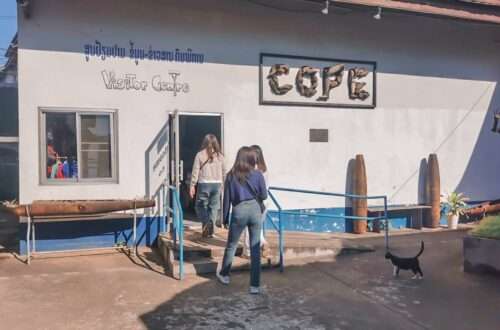
Vientiane To Dos: A Comprehensive Guide
Vientiane, the capital of Laos, is a comparatively laid-back and less chaotic city of your usual Southeast Asian metropolises.
From the moment I landed at Wattay International Airport in Vientiane, I knew I’d stepped into a relatively less visited yet charming country.
Instead of big brand shops and hordes of tourists pulling expensive luggage in a powerfully air-conditioned building, all I saw were small shops selling travellers’ necessities like SIM cards and city bus fare. There were no pushy taxi drivers, no particular urgency to leave the airport, and no feeling of being suffocated by noise and crowds.
While my time spent in Vientiane is limited, as the city was still too polluted to my liking, I had an enjoyable time exploring the sleepy town. There’s always something interesting around the corner – colourful gilded temples, chic cafes, or local eateries crowded with locals digging into delicious noodles.
So here’s a post on my travels in Vientiane, and how you can enjoy Vientiane like I did.
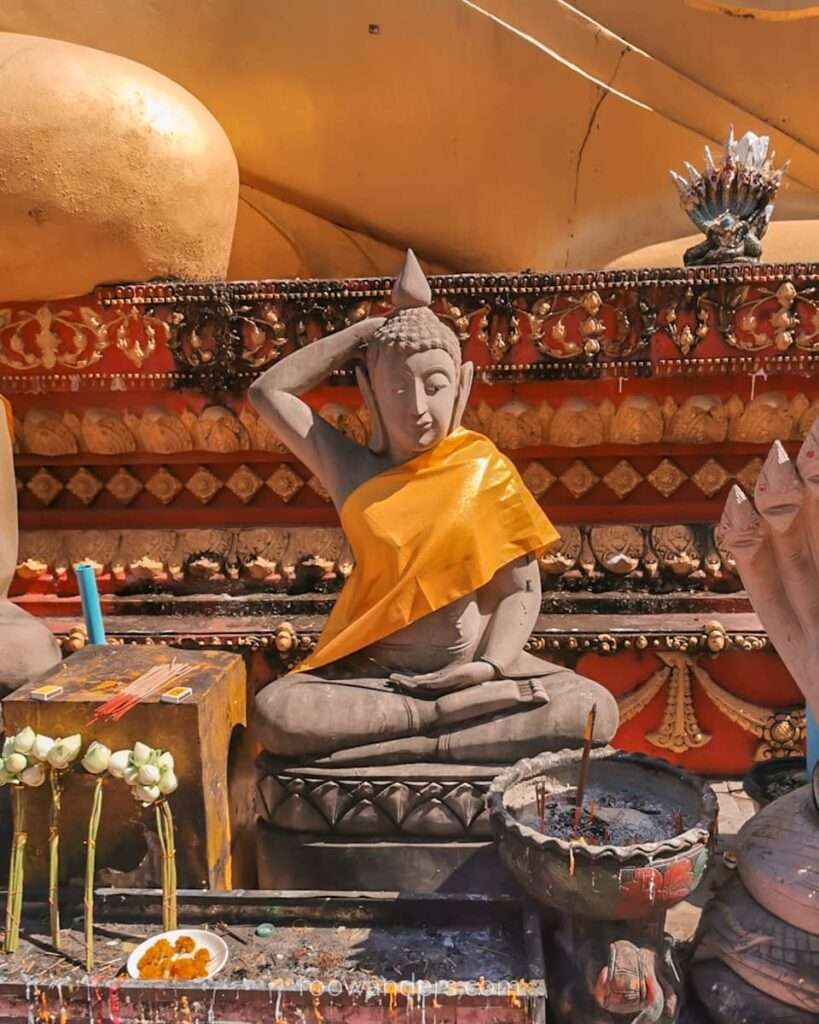
I visited Vientiane in Nov 2023. This post contains affiliate links that cost nothing to you but support my blog! It may also be updated periodically. Cheers!
Admin Stuff
Visa
Citizens of the member states of ASEAN (Brunei, Cambodia, Indonesia, Malaysia, Myanmar, Philippines, Singapore, Thailand, and Vietnam) are exempted from visas for up to 30 days.
Countries like Japan, South Korea, Switzerland, Luxembourg, Russia and Mongolia also enjoy visa-free entry of 15 or 21 days.
For the rest, apply for a Visa on Arrival at the entry ports or online here at the official website. Have some spare passport photos, proof of accommodation and a US$ 50 ready for the visa. An outward-bound ticket may be needed. The visa grants 30 days of travel within the country.
Travelling into Vientiane
Laos is a landlocked country surrounded by Kunming, China, and Myanmar at the north, Vietnam at the east, Thailand at the west, and Cambodia at the south. The Mekong River, the longest river in Southeast Asia, weaves through all six countries, resulting in a variety of transport options.
Flight
Vientiane, the capital city of Laos, has an international airport – Wattay International Airport – with direct flights from several countries.
Coming from Singapore, there’s Scoot that flies into VTE three times a week – Tue, Thu, Sat – in the afternoon. The journey takes 3 hours.
There are also direct international flights from Vietnam, Thailand, Cambodia, China, and Korea.
Check for your best flights here.
Train
The new Laos China Railway shortens the journey from Kunming, China, to Vientiane via rails from days to 8 hours. Getting a ticket, however, can be rather taxing if you’re doing it yourself. Most travellers would rather book from 12Go.
Sleeper trains from Bangkok, Thailand connect to Vientiane via the Friendship Bridge over the Mekong River. I’ve never taken a sleeper train in Thailand, but it may be similar to the sleeper I took in Vietnam on the Reunification Express Line.
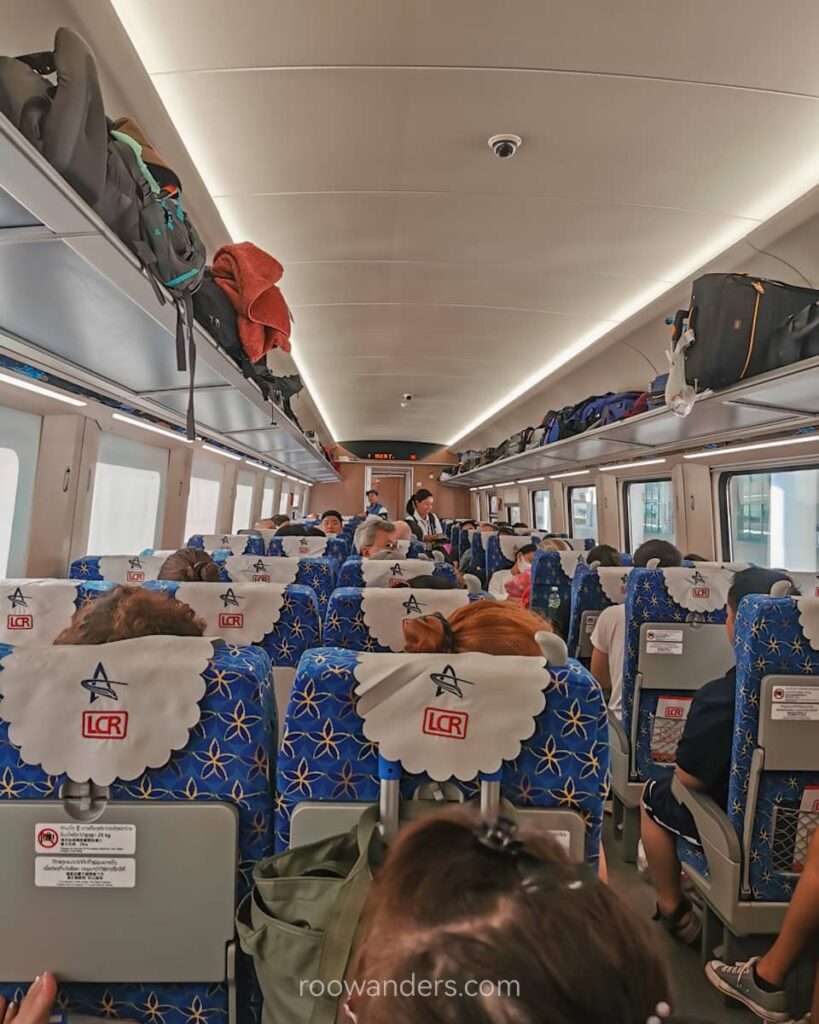
Bus
There are three bus stations in Vientiane with buses travelling on different routes.
The Central Bus Station covers both long and short-distance buses within the city, the Thai border, and the Southern and Northern Bus Stations.
The Northern Bus Station covers Northern Laos, including journeys into China.
The Southern Bus Station covers Southern Laos, including journeys into Vietnam.
Most accommodations, at least in my hostel, can arrange bus tickets. You could also purchase them online from 12Go or Baolau.
Boat
Another popular mode of transport is the 2D1N slow boat from Thailand to Laos. There are tour operators who could arrange for a hassle-free way of travelling via the slow boat from Chiang Mai, Chiang Rai, or Pai to stops between Huay Xai and Luang Prabang in Laos.
From Huay Xai, you could take a 2D1N cruise down the Mekong River to Vientiane.
Motorbikes
Make sure the motorbike is truly yours if you’re riding it across the immigration. Do not ride a rented bike across the border, unless you’re travelling with a travel agency that offers tours of such nature.
The police will definitely ask for evidence.
Money
Cash is king in Laos. Clean and crisp USD, and occasionally the Thai Baht, are accepted in most establishments, but the Laotian kip is still the preferred way to go. Some places with tourist presence accept cards, but cards incur additional charges.
You could draw your cash in all ATMs. The best rates are usually at the airport. Maximum cash per withdrawal is 2500k kip for BCEL, with another 20k to 30k kip transaction fee. My cash withdrawal using YouTrip totalled up to S$165 at Wattay International Airport.
I tried to draw my cash using Trust from BCEL, but it didn’t work. In the end, I had to go with YouTrip. Trust card works as a credit card with no cash withdrawal or forex charges, while YouTrip works as a prepaid card and free cash withdrawal for the first S$400 of the month. If you haven’t had a Trust or YouTrip card yet, do me a favour and sign up with me under codes SURW9MK5 (download the Trust app for iOS or Android) and here (Youtrip).
Laotian Kip is nearly worthless beyond its borders, so use them all before leaving.
Travelling within Vientiane
From Airport
Wattay International Airport has bus shuttles into the city for 40k kip per person. They operate from 8 AM to 8.30 PM on a relatively hourly basis.
If you are more than one traveller, getting a taxi is much more convenient and cheaper per pax.
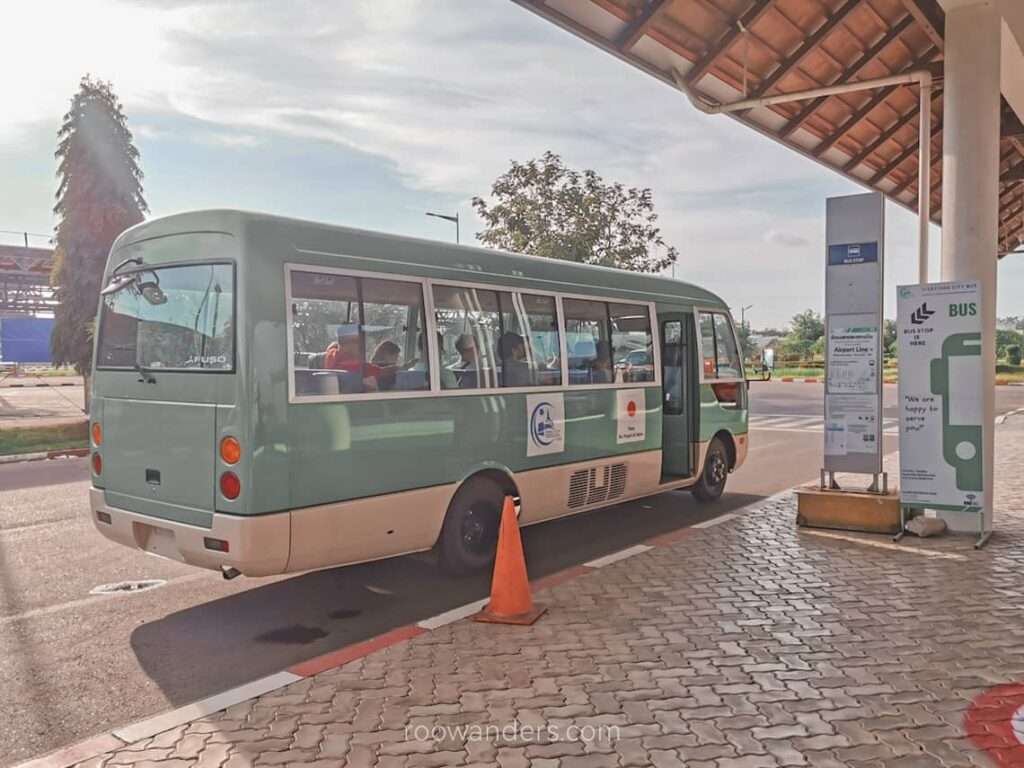
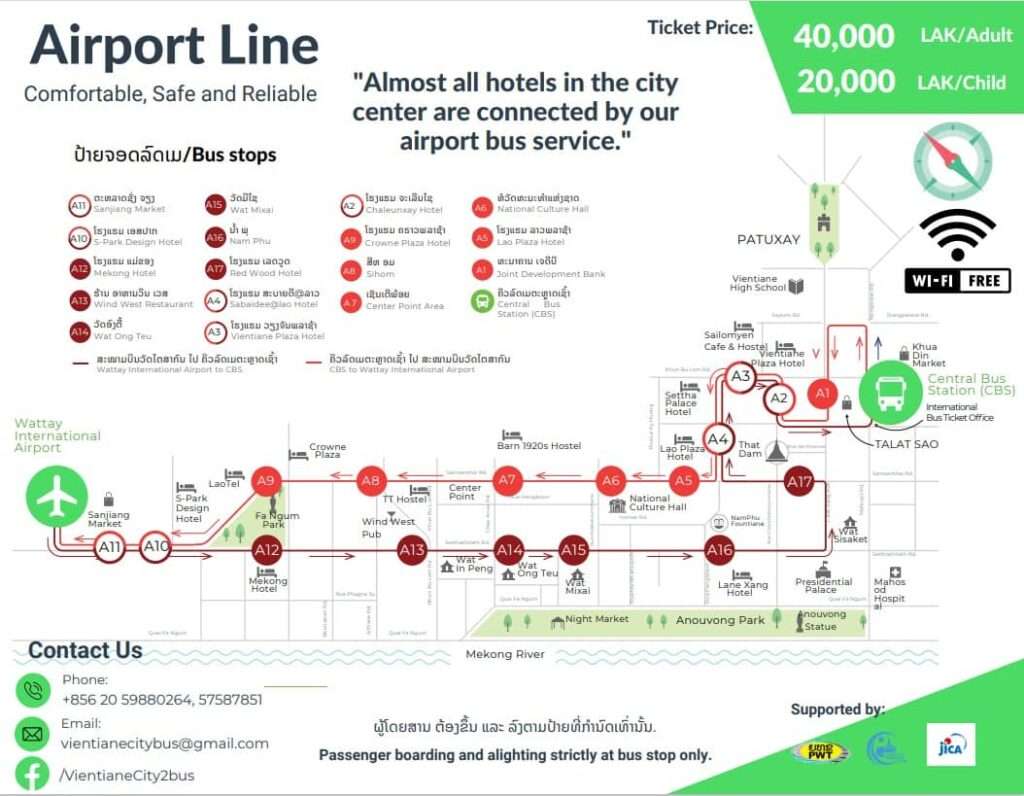
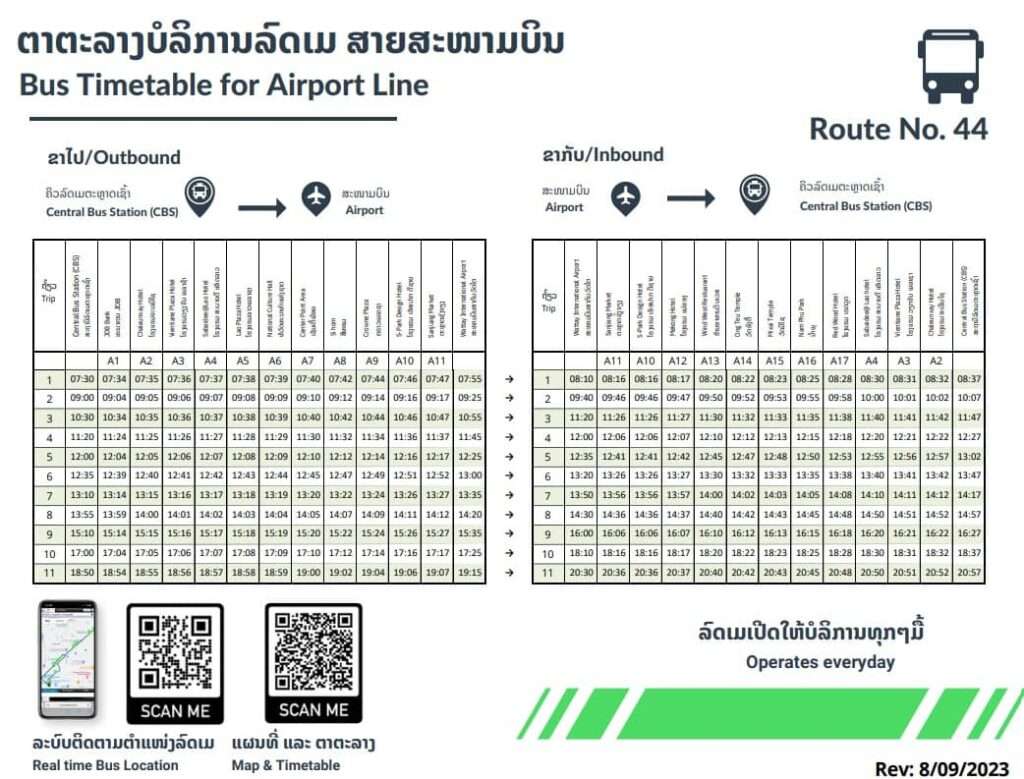
Walking
I walked everywhere in Vientiane to get to the sights and eateries. Unlike the roads of Thailand or Vietnam, Laotians do not honk all the time, and there are proper pedestrian crossings. For places that are further away – Pha That Luang – we called for a taxi.
Ride Hailing/ Taxi
Loca, a Thai-owned company, is like the Grab of Laos. You could use the app for payments, order takeaways, and call for a ride. However, this service is still predominantly used only in Vientiane and Luang Prabang. I accumulated enough points from two Loca rides to exchange for a free iced Americano in a partnering cafe.
Xanh SM is another new ride-hailing contender. Unlike Loca, Xanh SM owns its fleet of cyan taxis. The VinFast electric cars are new and quiet and travel smoothly within Vientiane. As my visit coincided with the month of their launch, we enjoyed one free ride on the first weekend, and two 50% off rides on the following weekend. They accept cash only.
Make sure you download their apps and create an account for each before using them, as this process takes time.
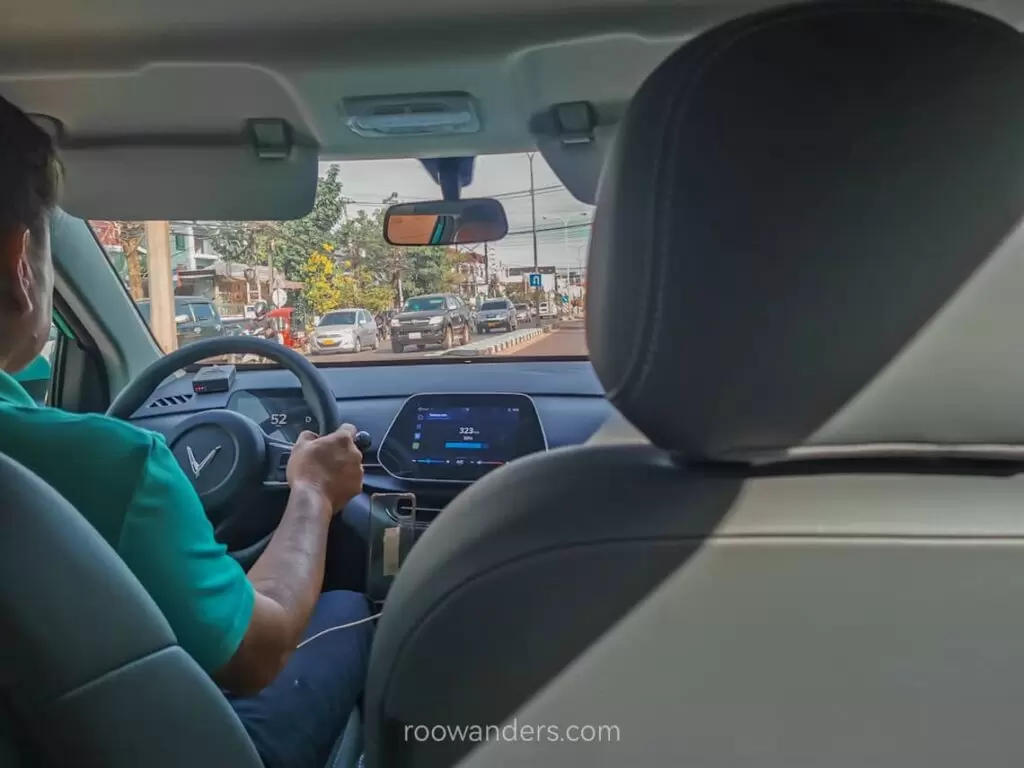
Bicycles or Motorbikes
You could rent a bike or motorbike to get around Vientiane. Some hostels loan bicycles for free.
However, roads in Vientiane can be pretty congested and difficult to navigate compared to the more laid-back towns of Vang Vieng and Luang Prabang. Maybe do that on a Sunday when roads are visibly less busy if you insist on riding a bike.
I like walking, and since most places are within reasonable walking distance, we stuck with walking.
Attractions within Vientiane
There aren’t that many attractions to visit in Vientiane, and you wouldn’t want to stay in this city for long due to the pollution. I’ve separated the Must-visits from the Could-forgos. Take your pick.
Alternatively, you could remove the hassle and join a guided tour. They’ll bring you to the key attractions within a day.
Must Visits
Pha That Luang
Pha That Luang is to Vientiane like Shwedagon Pagoda is to Yangon. The large golden Buddhist stupa located in the centre of Vientiane is the national symbol and most sacred monument of Laos. It is featured behind the kip notes and on the national seal.
Legend has it that missionary monks from India arrived in Vientiane carrying the breast bone of the Buddha in the 3rd century AD. The monks enshrined the relic with a stupa. Centuries passed, and the original stupa is no longer around. It was rebuilt into a Khmer temple in the 13th century, then destroyed by Siamese invasion and further conflicts until the 1930s, when the French rebuilt a replica based on old drawings of the Khmer temple.
Pha That Luang is a little over 4 km from the city centre – hire a taxi to get there.
Tickets cost 30k kip per person, and the place is open for visitation from 8 AM to 5 PM. Make sure you’re dressed conservatively!
Apart from Pha That Luang, there is also a sleeping Buddha (Wat That Luang Tai) and other temples around its vicinity.
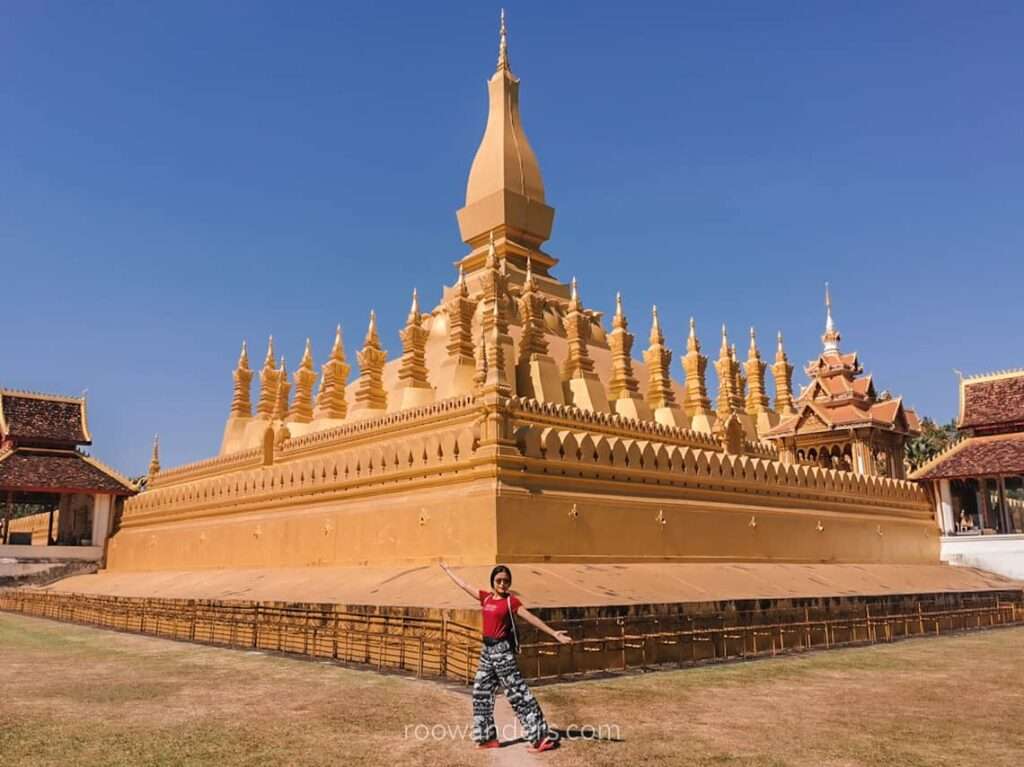
Location: That Luang, Xaysettha 10009, Laos
Patuxai
Reminiscent of the Arc de Triomphe in Paris and the India Gate in New Delhi, Patuxai commemorates the soldiers and people who lost their lives in the struggle against the French and WWII.
Built using funds from the Americans in the 1960s, Patuxai derived its name from the Sanskrit, where ‘patu’ meant door or gate, and ‘xai’ a derivative of ‘jaya’ which meant victory.
While the monument may have been inspired by the one in Paris, its design is everything but French. It has four corner towers, a central tower symbolising the five Buddhist principles, and an interior richly decorated with lotus, elephants, nagas and kinnaris.
Entry to the park is free, and you pay 30k kip to climb the seven-storey to the top. The gate is open from 8 AM to 5 PM, while the park is open all day. There’s a fountain show every evening, where locals and travellers congregate and enjoy the performances.
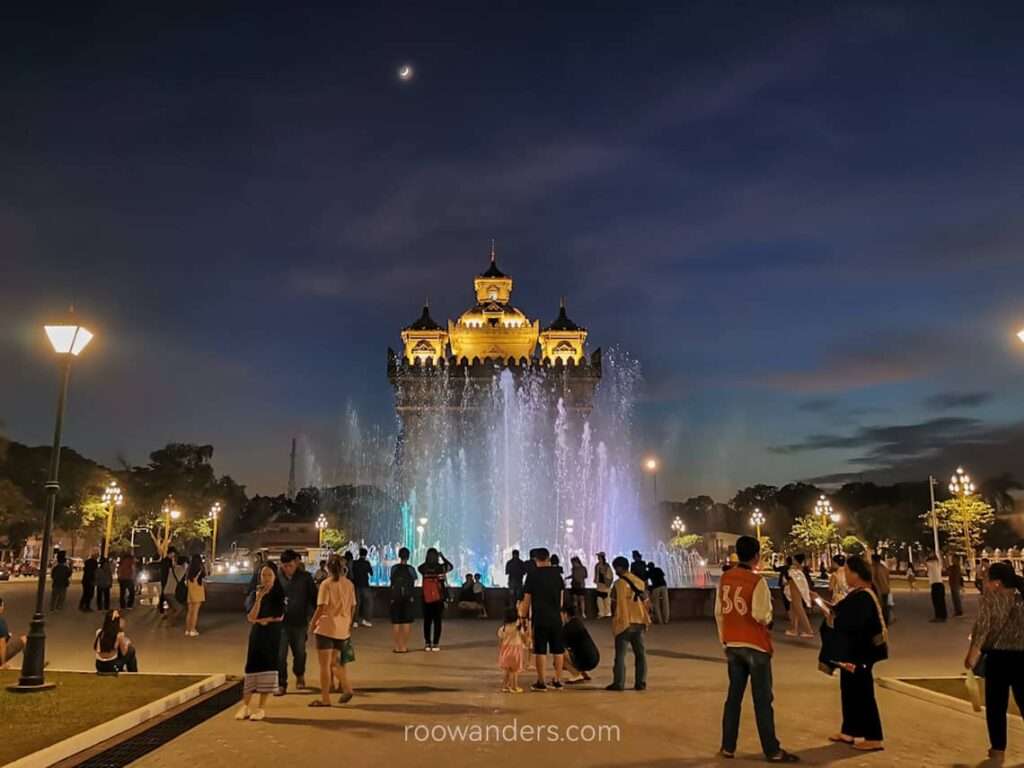
Location: Patuxai Park
COPE Visitor Centre
COPE (Cooperative Orthotic & Prosthetic Enterprise) is an organisation in Laos in charge of supplying artificial limbs, mobility aids and wheelchairs to victims hurt by UXO (unexploded ordnance). If you’ve not already known, Laos is the world’s most bombed country in the world as a result of the neighbouring Vietnam War.
Part of the Ho Chi Minh trail used by the Northern Vietnamese troops goes into Laos. The Americans heavily bombed those areas to thwart their progress.
While the war has since ended more than 40 years ago, undiscovered UXO continues to maim and kill people. It could take another century before all the bombs are disposed of.
I was so inspired by COPE, I wrote an article here.
Dedicate an hour or two to the visitor centre that offers a variety of exhibits about prosthetics and UXO in Laos. COPE is free to visit and is open from 8.30 AM – 4 PM, but a donation is highly appreciated.
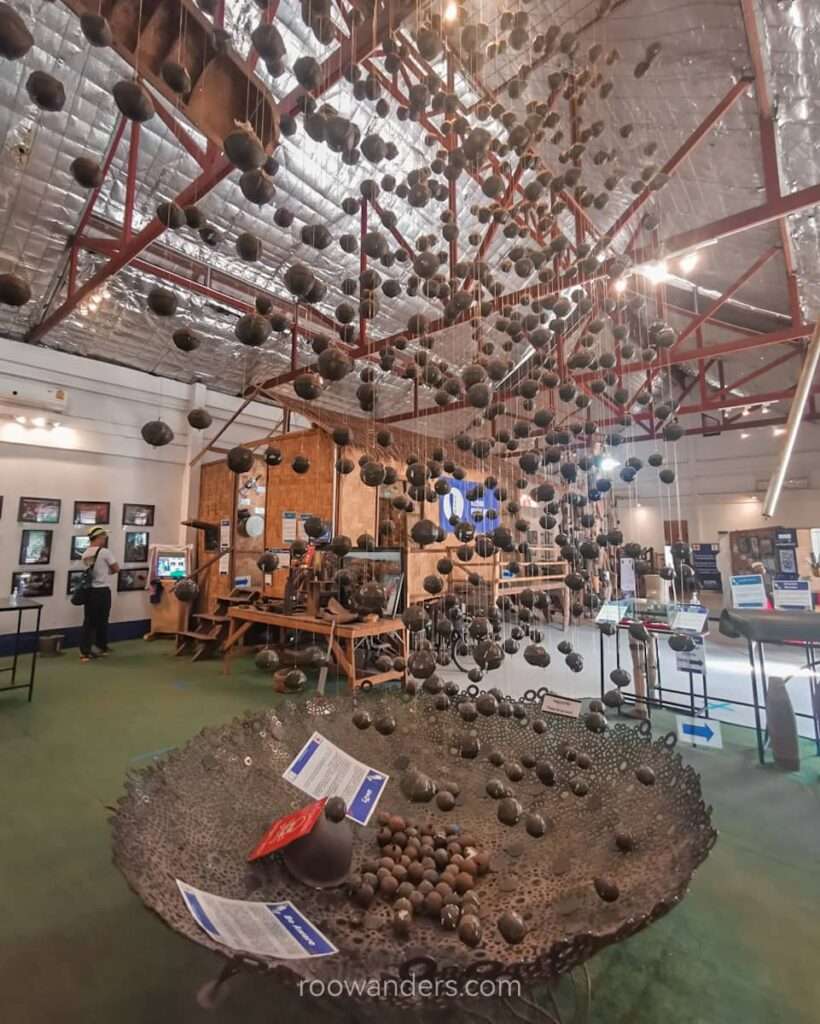
Location: Boulevard KhouVieng, Vientiane, Laos
Night Market
Spend an evening shopping or eating in the night market by the Mekong River facing Thailand. If shopping isn’t your thing, the walk by the riverside is still a nice stroll after dinner. There’s a mini amusement park by the night market.
The night market is open from 6 PM to 10 PM every day.
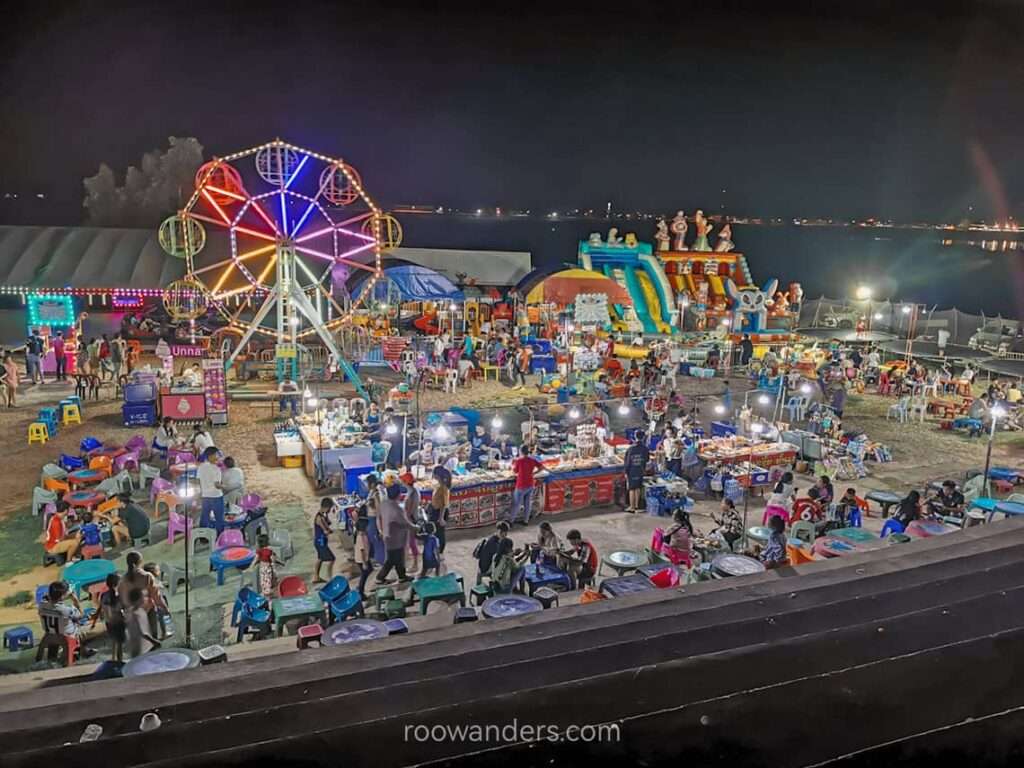
Location: Night Market by the Mekong River
Temples
Laos is a Buddhist country, which explains the myriad of temples of all shapes and sizes. You can easily wind up in one by just walking down the streets. My take is to visit the first two from the list below, or else you might suffer from temple fatigue.
Wat Sisaket
Wat Sisaket, located on Lan Xang Road, northwest of Haw Phra Kaew, is the only temple spared from the Siamese invasion in 1828. Built between 1819 and 1824 by King Anouvong, the last valiant king of the Lao Kingdom of Vientiane, Wat Sisaket features over 10,000 Buddhas within and around the ordination hall.
The temple is open every day from 8 AM to 4 PM with an hour lunch break in between. Ticket cost 30k kip.
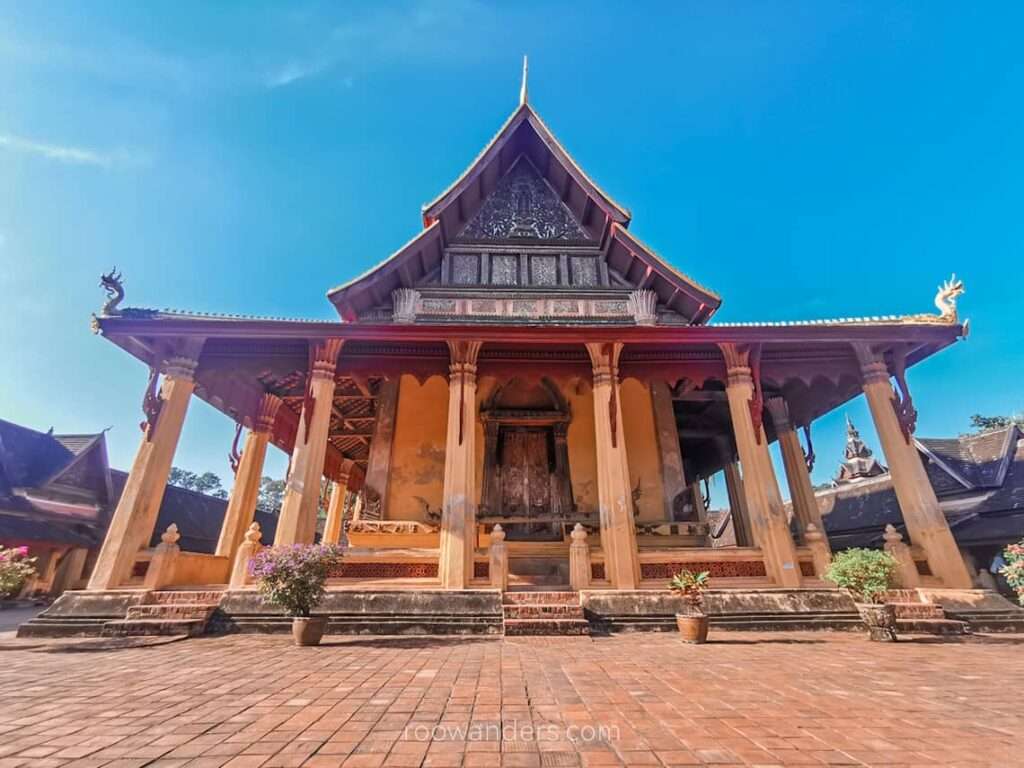

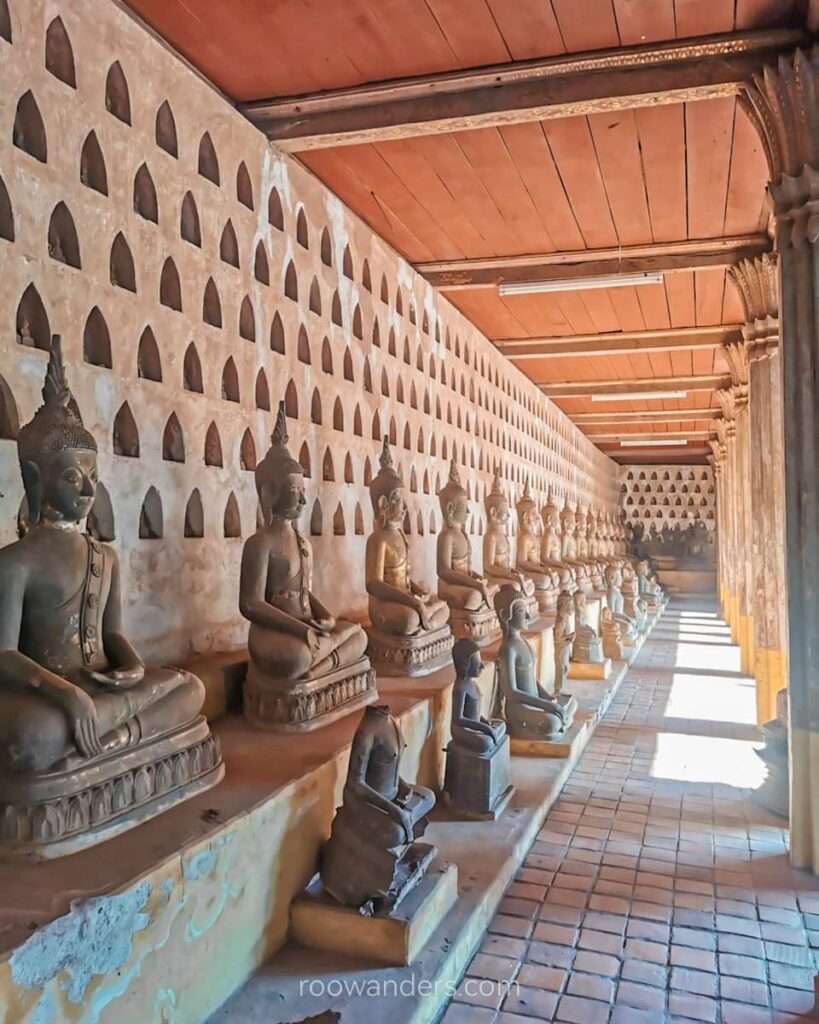
Location: Ave Lane Xang, Vientiane, Laos
Ho Phra Keo Museum
Ho Phra Keo was once a Buddhist shrine dating back to 1565, meant to house the Emerald Buddha when King Saysetthathirath of Lane Xang Kingdom moved the capital from Luang Prabang to Vientiane.
Located just past the Presidential Palace, the shrine no longer has the Emerald Buddha – it is now in Bangkok – and has since been converted into a museum with many artefacts such as more bronze and stone buddhas, 6th-century stone sculptures and tablets, and other Laotian treasures.
Tickets cost 30k kip, and the museum is open everyday from 8 AM to 4 PM with an hour lunch break in between.
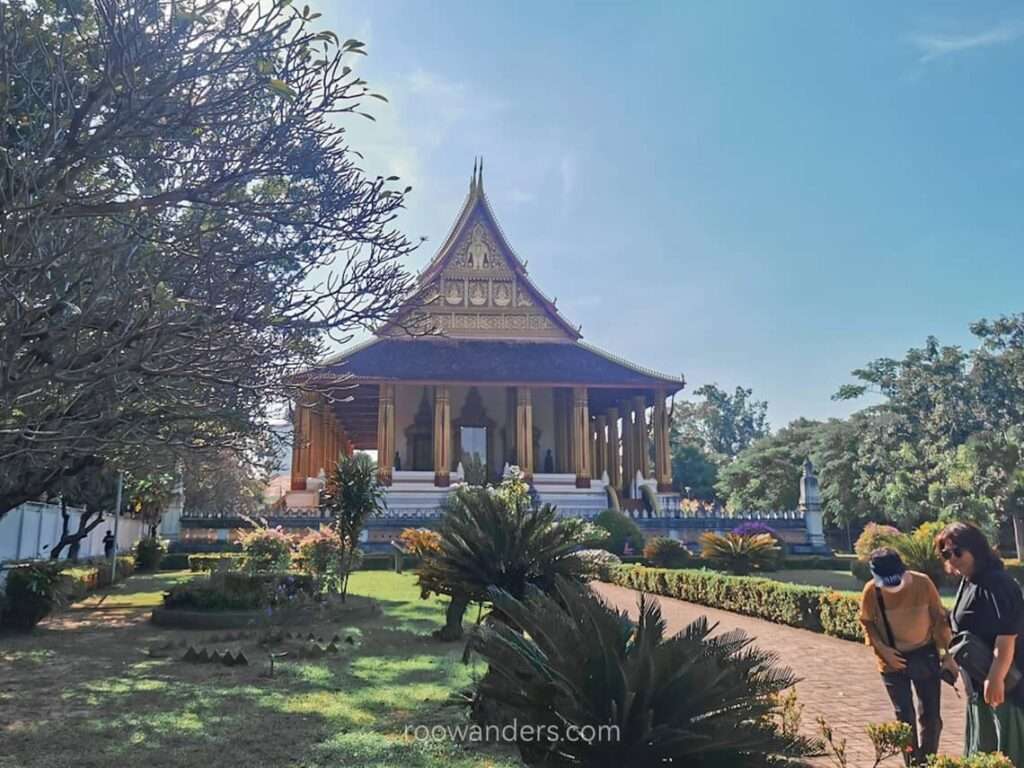
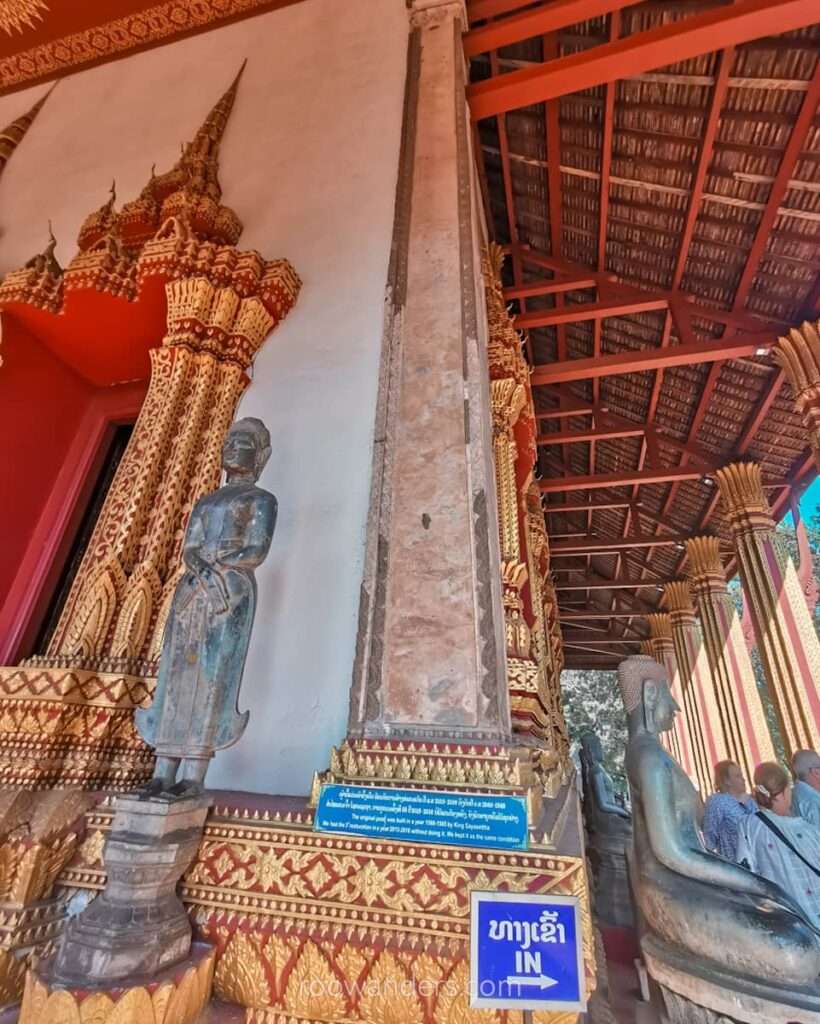
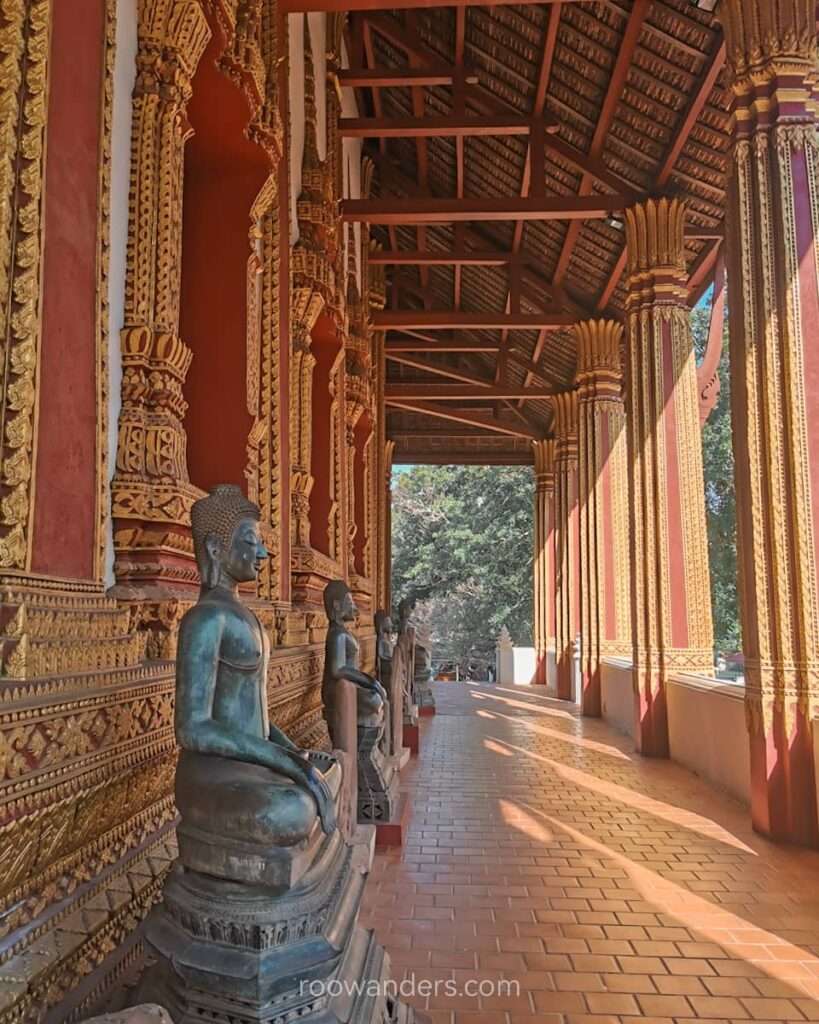
Location: Same road as Presidential Palace on Rue Samsenthai
Wat Inpeng
An active temple with a beautiful green facade.
Location: Near the junction of Rue Samsenthai and Khun Bu Lom Road
Wat Ong Teu
A working temple with several buddhas, a drum tower, a stupa and other smaller buildings. Free to visit.
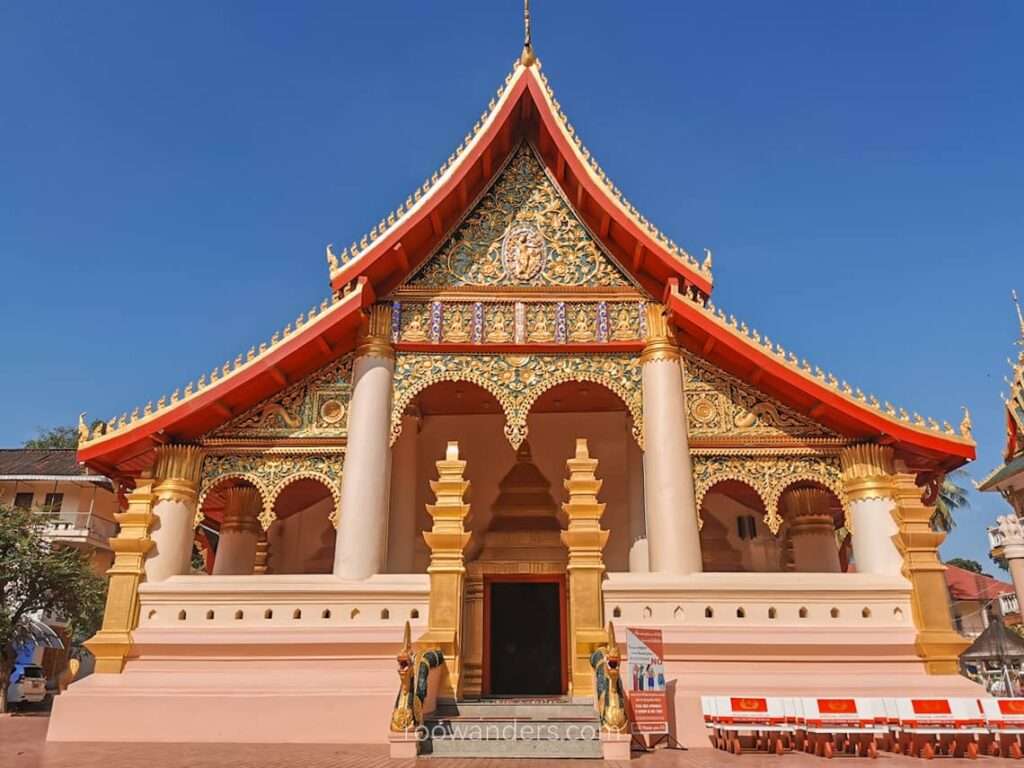
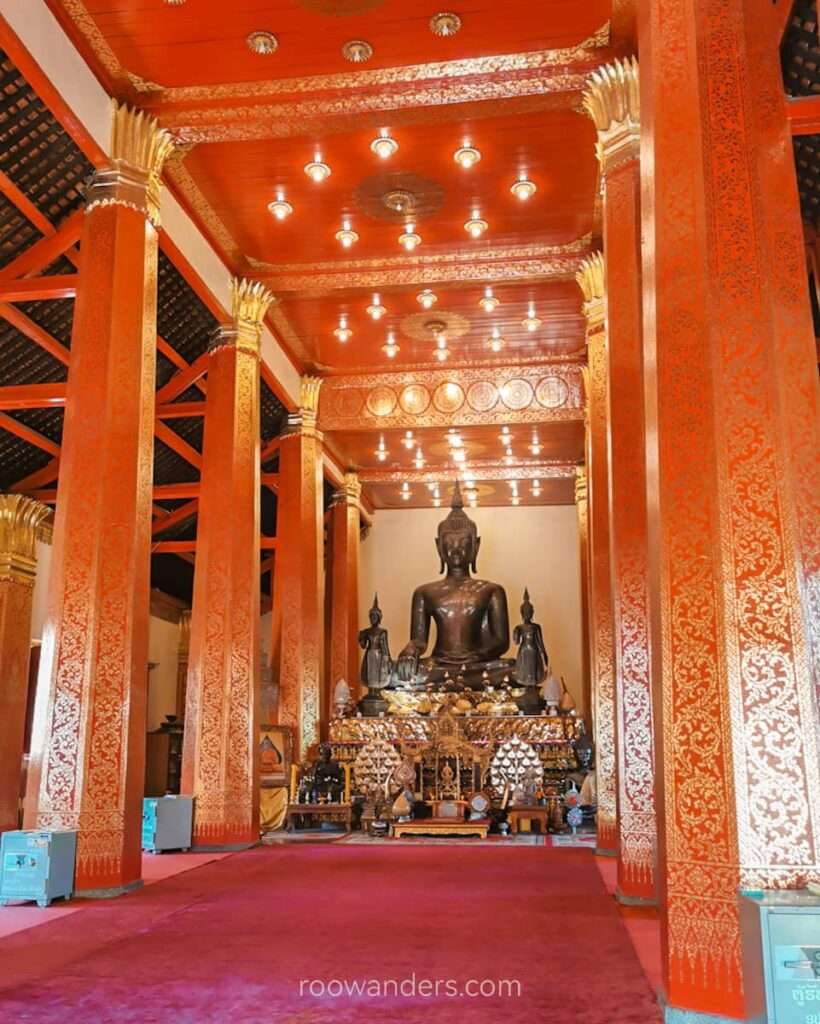
Location: Near the junction of Chao Anou Road and Rue Samsenthai
Wat Si Muang
Another temple located closer to COPE. Free to visit.
Location: 15 Rue Bourichane, Vientiane, Laos
Miscellaneous Sights
That Dam Stupa
The mysterious dusty brown stupa overgrown with weeds and shrubs has probably stood in the same place for aeons and witnessed the aftermath of the Siamese invasion and Indochina Wars.
That Dam Stupa, which means the ‘Black Tower’ in Laos, was claimed to be gilded but was stripped of gold during the invasion. Locals believe that a seven-headed naga resides within the stupa.
Visiting it is free as it is located in a quiet roundabout between Chantha Khoumane Road and Bartholonie Road.
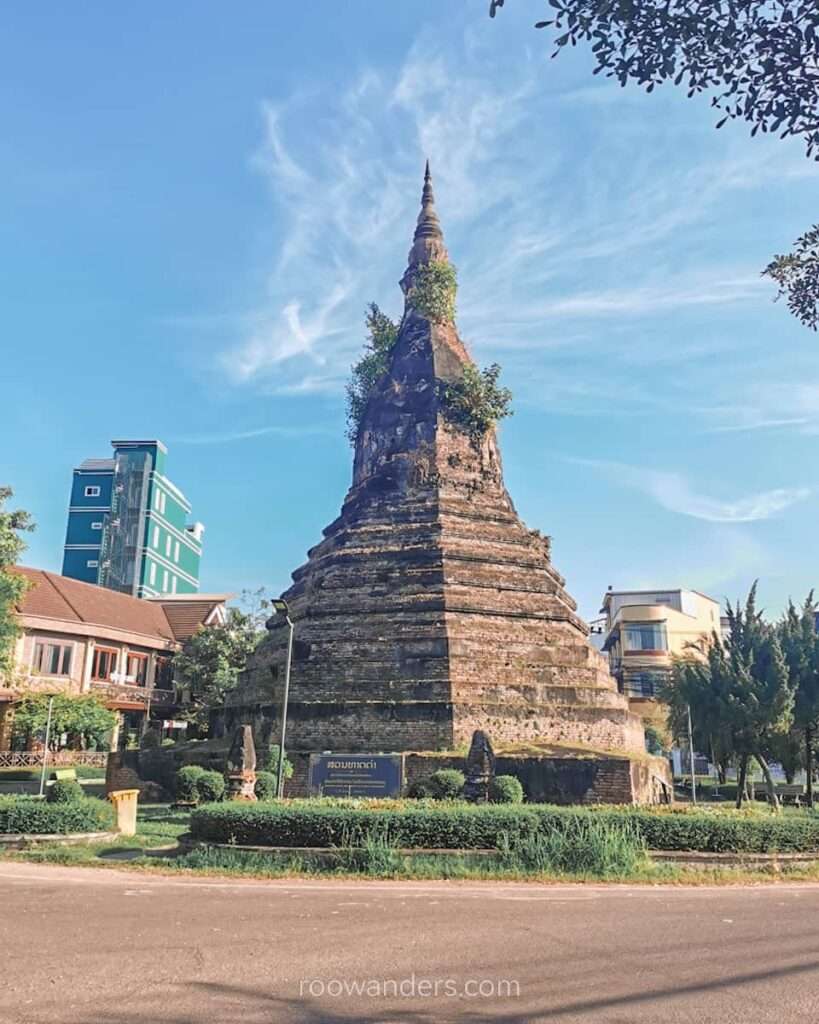
Location: 140 Rue Samsenthai, Vientiane, Laos
King Anouvong Statue
Located at the end of Vientiane Night Market at the Chao Anouvong Park stood the tall and proud valiant King of Vientiane. King Anouvong was erected in 2010 to commemorate the 450th anniversary of the founding of the city of Vientiane. It faces the river towards Thailand.
King Anouvong ruled the Vientiane Kingdom from 1805 to 1828. Despite being the king, his kingdom, together with the Kingdom of Champasak and Luang Prabang, was actually under the control of neighbouring Siam. Disgruntled with the Siamese rule, the king did minor rebellious acts like constructing Wat Sisaket in such a way that visiting subjects turned their backs on Bangkok.
It was not until the succession of King Rama III that things took a worse turn. The new king discriminated against and abused Laotians. In 1826, King Anouvong heard that foreign powers were about to invade Siam and took the opportunity to rebel. But he misheard the information and his blunder soon cost him his kingdom and life.
Centuries passed, and Laotian continued to revere the king for his struggle and courage.
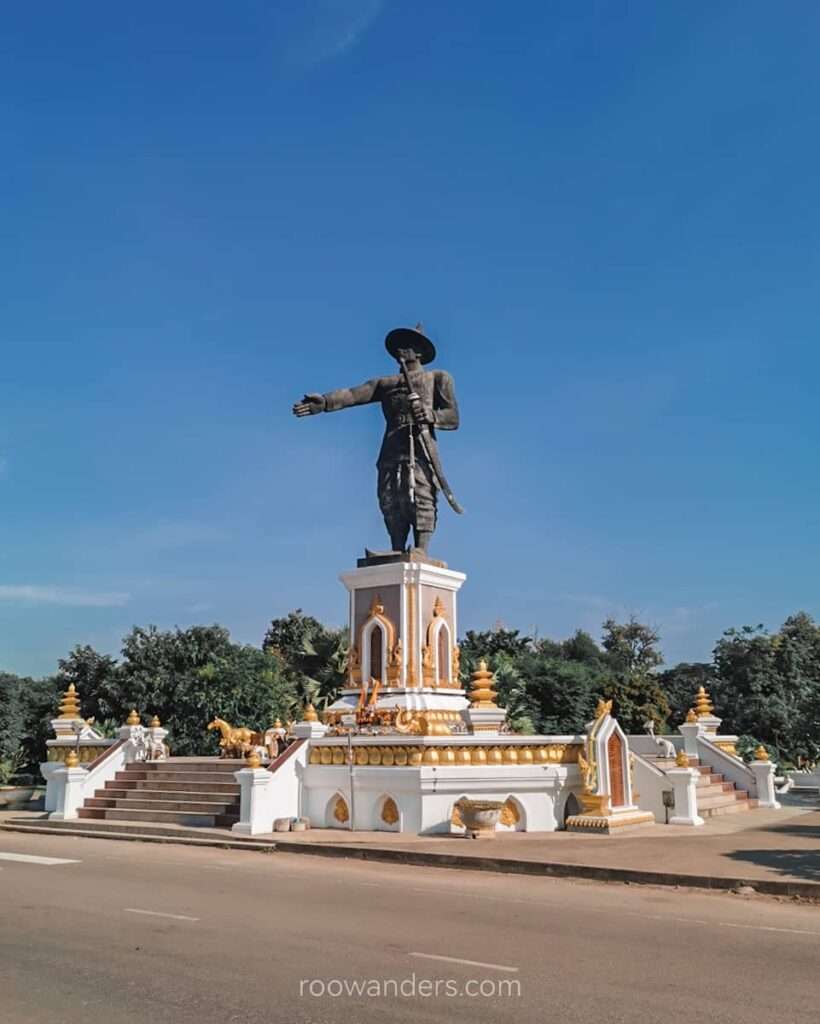
Location: Mekong Shore Boardwalk, Vientiane, Laos
Buddha Park
Also known as Wat Xieng Khuan, the sculpture park 25 km southwest of Vientiane isn’t really a Wat. Rather, the park is home to hundreds of Hindu and Buddhist statues that are relatively new (built in 1958), making it an eccentric place to visit.
The tickets cost 40k kip, and the park is open from 8 AM to 5 PM.
Location: Deua, Thanon Tha, Vientiane, Laos
Lao National Cultural Hall (Special)
There’s actually nothing interesting about the cultural hall, but I’d like to just include it in my list as this place may sometimes hold interesting events on the weekends.
On Saturday I visited, there was a K-pop audition going on in the evening, and the empty lot beside the Cultural Hall was packed with a stage complete with huge blasting stereos, several F&B booths, and young people dancing and singing to K-pop songs.
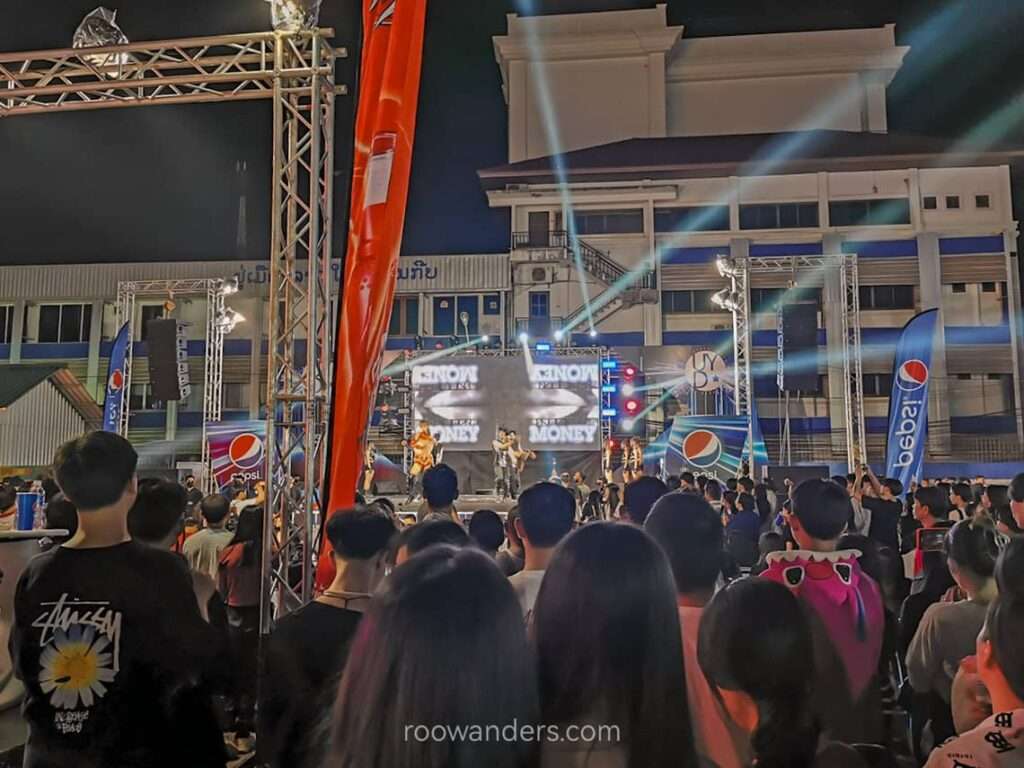
Location: 138 Rue Nokeokoummane, Vientiane, Laos
Places to eat in Vientiane
Food Park Center Point
I insisted on local food for my first meal, and the guys in my hostel recommended that I visit here.
Open only in the evenings from 5 PM onwards, the Food Park Center Point is popular amongst the locals. It gets busier as the night grows. The place is like a food bazaar teeming with stalls selling all sorts of food, from BBQ meats to sushi (?), dried fish and drinks.
I had a great time sharing a table with a duo who recommended me to Larb Pla Meuk – a filling whole squid salad for 95k kip. They later left, another duo joined my table, and we discussed his travels in Singapore and his business in Luang Prabang. That’s when I learnt about Xanh SM and bought a Longan drink for 15k kip. As you can see, expect to share tables with others if you’re eating alone.
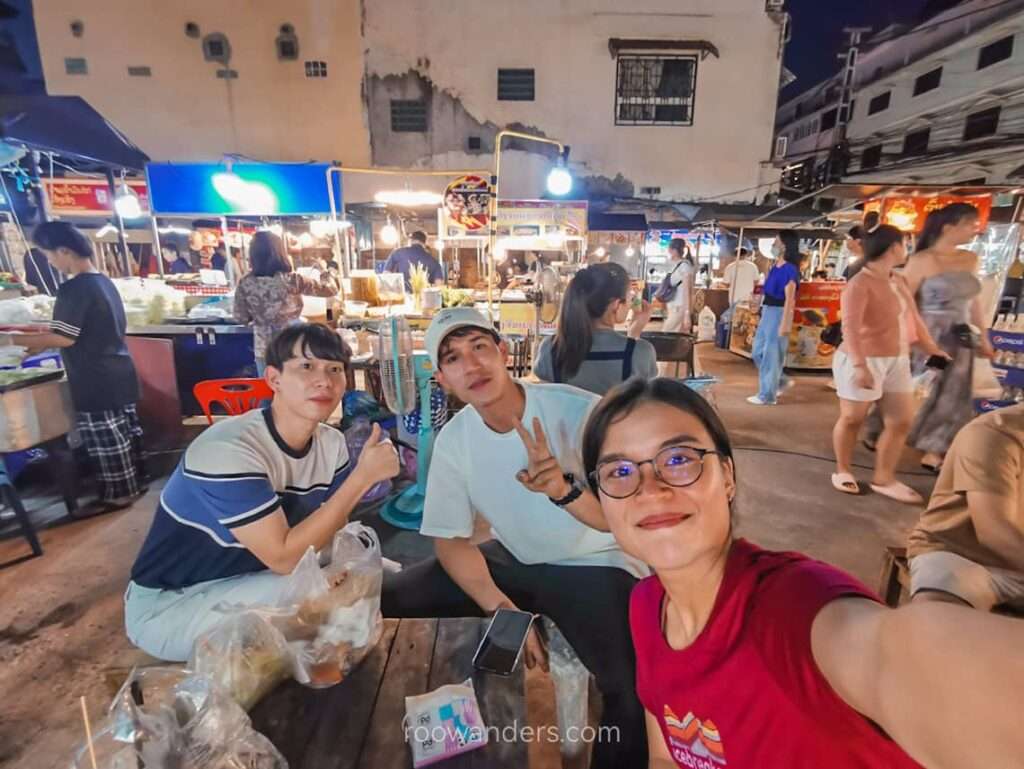
Location: In between Hanoi Rd, Rue Toulan and Rue Hengboun
Nemsihom
I haven’t eaten here yet, but it looks popular amongst the locals. The eatery does hot pot.
Location: Along Rue Hengboun
Han Sam Euay Nong – Three Sisters
A place owned by three sisters recommended by my hostel. Locals frequent this place too. We had some more noodle soup and fermented pork, Naem.
Location: Towards the end of Chao Anou Road
NUAN
A good place to sort out your meals if you don’t know what to get. They offer a selection of delectable rice bowls and have happy hour draught beer Lao. Take your meals on the second floor where interesting art pieces hang.
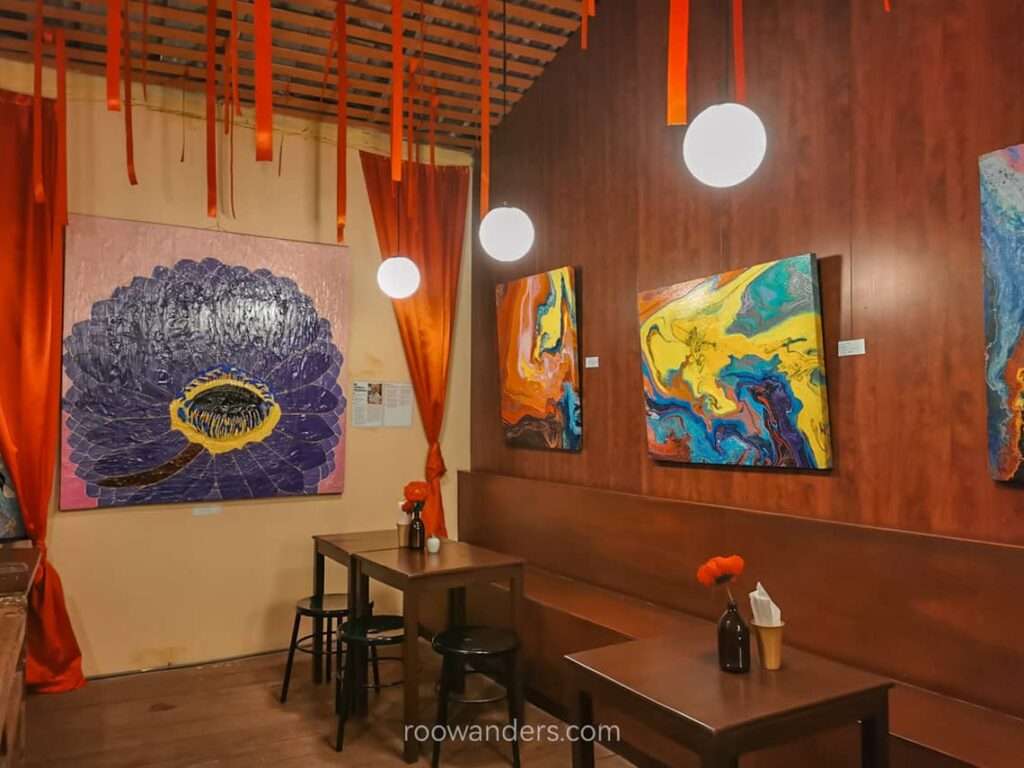
Location: At the junction of Rue Setthathilath and Rue Pangkham
Delicious Noodles
We had noodles for breakfast at this local shop for about 40k kip for two.
Location: Khun Bu Lom Rd, Vientiane, Laos
PVO Vietnamese Food
I haven’t been here yet but was recommended to go by one of the duos I met for my first meal.
Location: Rue Setthathilath, Vientiane, Laos
Accommodations in Vientiane
Budget Hostel. Since I was travelling alone, I stayed with the hospitable and affordable Barn 1920s, which has female dorms. I stayed on both occasions in their 4-bed and 14-bed rooms and found no big difference between the two. They’ve designed the cubicle to maximum privacy even if you’re in a dorm. Other hostels to check out include Nana Backpackers which my travel buddy stayed at, and TT Hostel, which has good reviews too.
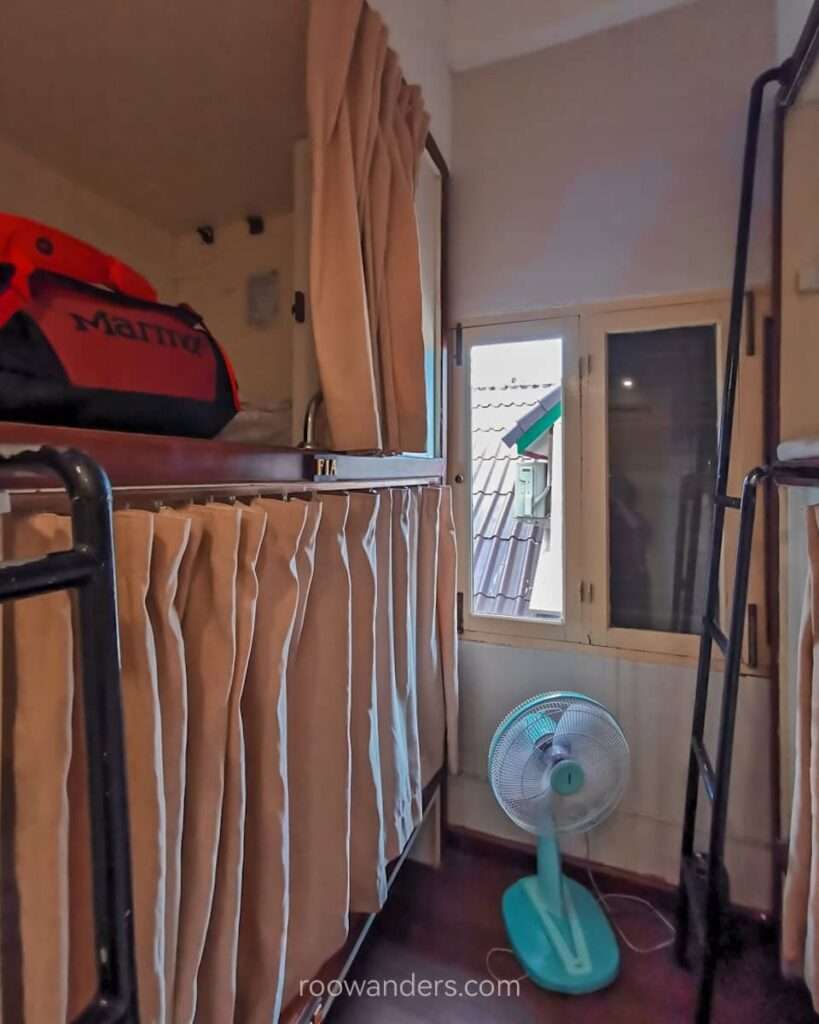
Mid-tier hotel. Three-star SYRI Boutique, Vientiane Boutique Hotel and Centerpoint Boutique Hotel are all within walking distance of most attractions and have very affordable rates.
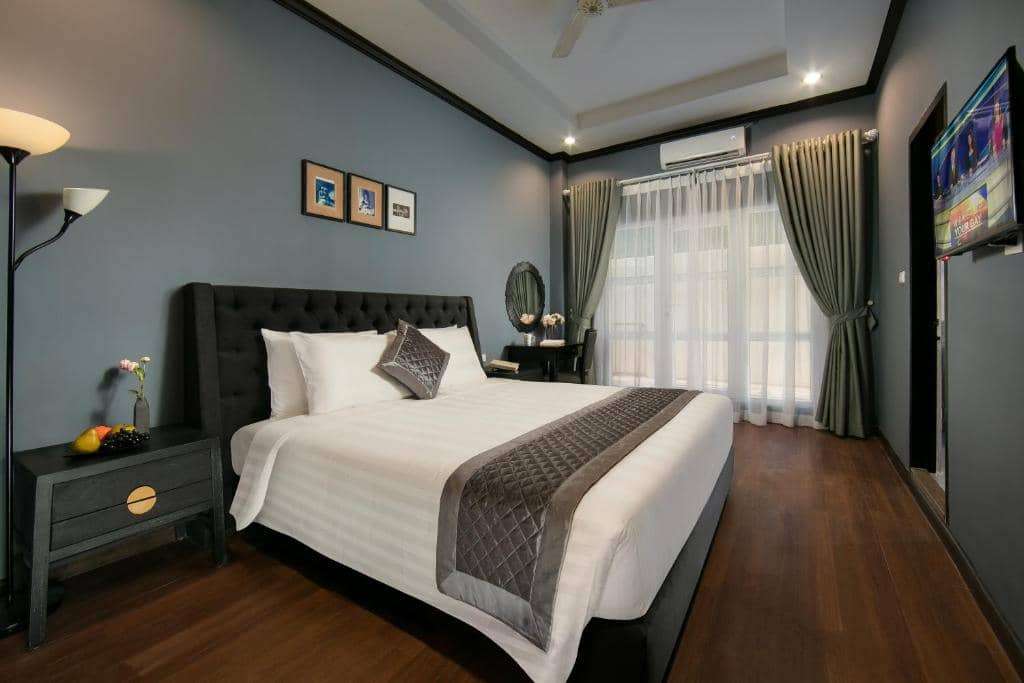
Luxury. For a luxurious stay, there is the beautiful five-star hotel La Seine Hotel. If you want something international, there is the Crowne Plaza and its pool. Muong Thanh Luxury is another serious contender.
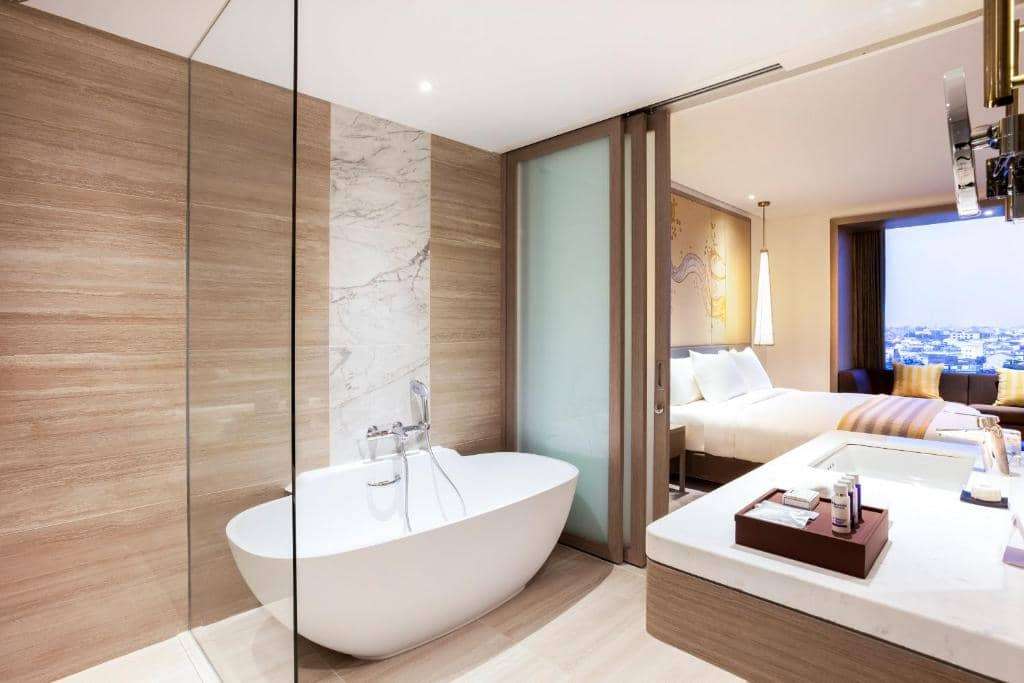
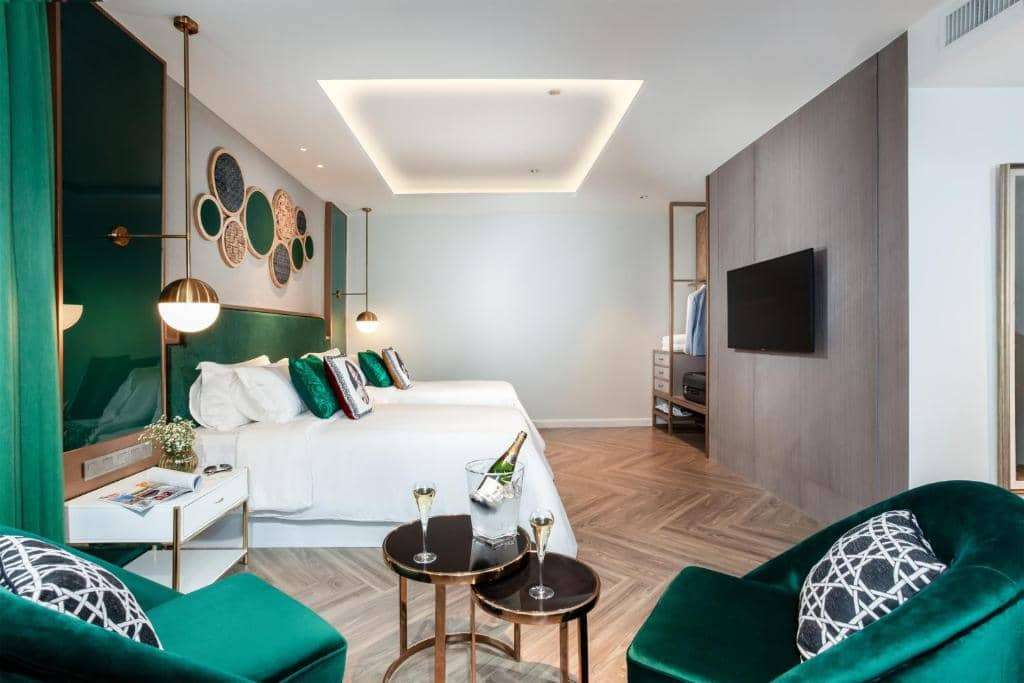
Travel beyond Vientiane
Vientiane is a good base to land and venture North to Vang Vieng, Luang Prabang and beyond, or South to Thakhek, Pakse and the 4000 islands.
For my week-long travels, I visited Vientiane, Vang Vieng, and Luang Prabang.
Here’s a brief summary of what to expect in the places of attraction beyond Vientiane.
North
- Vang Vieng. The next natural spot to visit from Vientiane for those on a classic week-long trip. Many imposing karsts and caves. Home to adventurers. You could paramotor or ride a hot air balloon here.
- Luang Prabang. Used to be the royal capital of the country. Many old temples date back to the 16th century. Beautiful street houses facing the river. A perfect base to launch into hikes around Northern Laos.
- Luang Namtha. A trekking destination. For those looking for an even more laid-back countryside vibe.
- Nong Khiaw. Another spot for adventure seekers. Offers opportunities to rock-climb, kayak and trek.
- Phonsavan. For the mysterious millennia-old Plains of Jars sites.
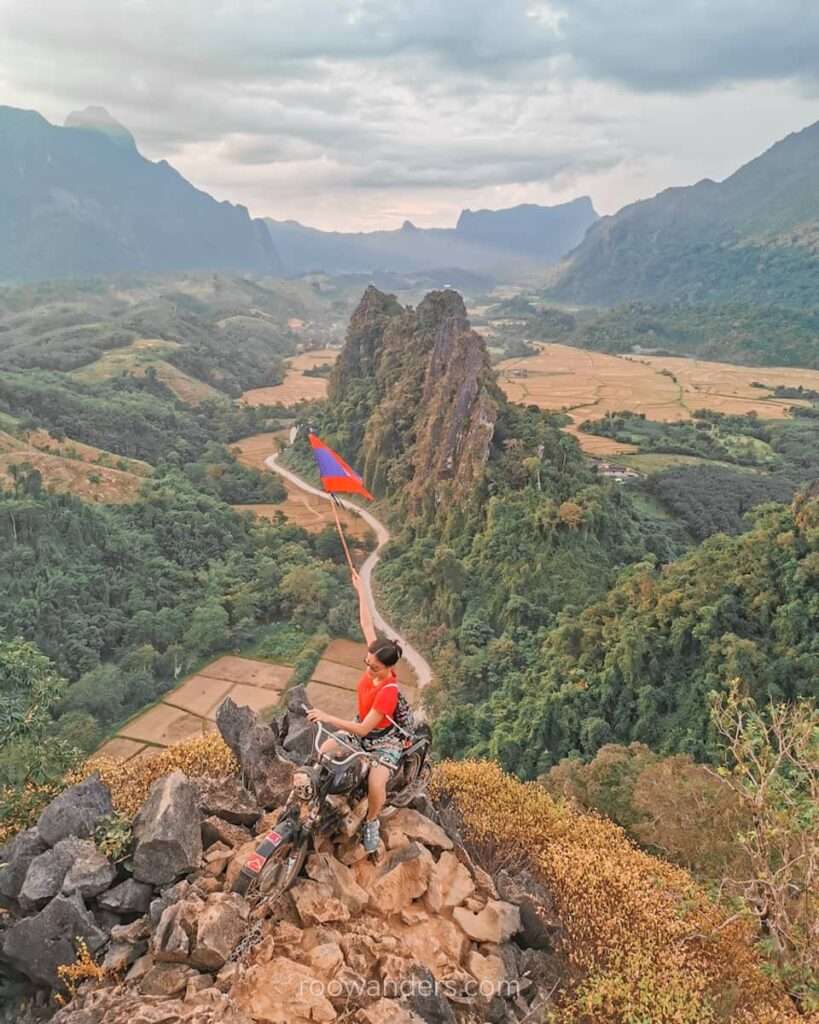
South
- Thakhek. There’s an adventurous 500 km loop through the countryside with the Kong Lor Cave as a key highlight of the 4 – 6 days trip.
- Pakse. Has an international airport, and another exciting 300 km loop peppered with numerous waterfalls known as The Bolaven Plateau Loop.
- Si Phan Don (4000 islands). A laid-back little town with numerous waterfalls. Spot the elusive freshwater Irrawaddy dolphins!
Conclusion
And there you have it – some ideas to get you started in your plans to visit Vientiane and the rest of Laos. For those short on time, like me, a full day is sufficient to cover the must-visits. You could lengthen your stay and weave in cafe-hopping and massages between temples and museums for a more relaxed vacation.





